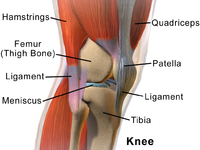
Photo from wikipedia
Recently, Hong et al. published on International Orthopaedics their article titled BIntra-articular injection of autologous adipose-derived stromal vascular fractions for knee osteoarthritis: a double-blind randomized self-controlled trial^ [1]. We would… Click to show full abstract
Recently, Hong et al. published on International Orthopaedics their article titled BIntra-articular injection of autologous adipose-derived stromal vascular fractions for knee osteoarthritis: a double-blind randomized self-controlled trial^ [1]. We would like to congratulate the authors for their effort in performing the first RCT on the use of adipose-derived stem cells to treat knee OA. However, there are some methodological concerns that we would like to share. First, the number of the patients included in their trial seems extremely low compared to similar papers already published on biologics injection [2, 3], especially considering that stem cells were tested against an active comparator (HA) and not against placebo. The authors refer to a previous pilot study, without specifying the primary outcome and the parameters used for their power analysis. Previous trials using similar evaluation tools have included a much higher number of patients, sometimes close to 100 per treatment arm [4], which is a reasonable number considering the standard deviation of WOMAC or other similar scores. The large difference in outcomes reported by authors between SVF and HA may justify a lower sample size but this seems more a post hoc than an a priori power analysis. In the BLimitations^ section, the authors state that Bthe sample size was small because the incidence of bilateral knee osteoarthritis was lower than unilateral knee OA^ but this sounds confusing since a proper power analysis should have guaranteed the inclusion of an appropriate number of patients, and if Bbilateral knee OA was lower than unilateral^ (this statement is also questionable), it would have been easier and more meaningful to include monolateral patients. In fact, the choice of treating patients in both knees may be a further flaw, since the questionnaire used, as recognized by authors, cannot independently score both knees of one patient because the results of one knee might affect the contralateral one, as shown in many studies [5]. This requires a proper statistical evaluation, and a test with Bcorrection for patient^ (such as a general linear model with the patient as a random effect) should be used, but authors did not mention this specific aspect in their statistical analysis. To this regard, despite no difference at basal evaluation was documented between the knees treated by SVF or HA, the authors did not clarify one fundamental aspect, i.e., the eventual presence of any intra-patient difference between knees: in fact, in bilateral symptomatic OA, one knee could be significantly worse than the other and this may influence clinical results, especially considering that in the HA group, there were more patients with Kellgren III OA (9 vs 6). This difference, perhaps not statistically significant due to the low number of patients, should be kept into account when critically analyzing the results, and could justify the unsatisfactory outcome obtained in the HA group, where, in contrast with previously published trials, a relevant worsening of both clinical and radiologic parameters was documented, perhaps suggesting that in those knees, there was a more aggressive OA: if so, that could be justified again by the low number of patients included with inherent bias. Another issue regards the clinical application of SVF or HA, which is not fully clear. In fact, authors treated patients with bilateral OA but performed also arthroscopic debridement, which is currently a treatment not indicated in case of OA [6], to clean Blesions^ onto which they applied SVF or HA: so did they intend to treat OA * Berardo Di Matteo [email protected]
Journal Title: International Orthopaedics
Year Published: 2018
Link to full text (if available)
Share on Social Media: Sign Up to like & get
recommendations!